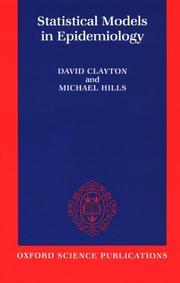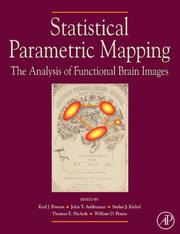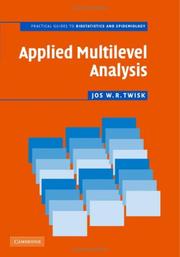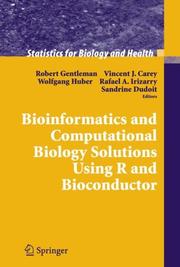| Listing 1 - 10 of 25 | << page >> |
Sort by
|

ISBN: 9780199671182 9780198522218 0198522215 Year: 1993 Publisher: Oxford Oxford University Press
Abstract | Keywords | Export | Availability | Bookmark
 Loading...
Loading...Choose an application
- Reference Manager
- EndNote
- RefWorks (Direct export to RefWorks)
Statistical methods --- Simulation models --- Models --- Probability analysis --- Epidemiology --- Disease surveillance --- Model, Statistical --- Models, Binomial --- Models, Polynomial --- Statistical Model --- Probabilistic Models --- Statistical Models --- Two-Parameter Models --- Binomial Model --- Binomial Models --- Model, Binomial --- Model, Polynomial --- Model, Probabilistic --- Model, Two-Parameter --- Models, Probabilistic --- Models, Two-Parameter --- Polynomial Model --- Polynomial Models --- Probabilistic Model --- Two Parameter Models --- Two-Parameter Model --- Models, Statistical --- Statistics as Topic --- Disease --- epidemiology --- Mathematical statistics --- Models, Statistical. --- Epidemiology. --- Statistical methods. --- Social Epidemiology --- Epidemiologies, Social --- Epidemiology, Social --- Social Epidemiologies --- Models, statistical
Dissertation
Abstract | Keywords | Export | Availability | Bookmark
 Loading...
Loading...Choose an application
- Reference Manager
- EndNote
- RefWorks (Direct export to RefWorks)
Growth Disorders --- Anthropometry. --- Models, Statistical. --- Body Weight --- Body Mass Index. --- Body Height --- Puberty --- Quetelet's Index --- Quetelet Index --- Index, Body Mass --- Index, Quetelet --- Quetelets Index --- Model, Statistical --- Models, Binomial --- Models, Polynomial --- Statistical Model --- Probabilistic Models --- Statistical Models --- Two-Parameter Models --- Binomial Model --- Binomial Models --- Model, Binomial --- Model, Polynomial --- Model, Probabilistic --- Model, Two-Parameter --- Models, Probabilistic --- Models, Two-Parameter --- Polynomial Model --- Polynomial Models --- Probabilistic Model --- Two Parameter Models --- Two-Parameter Model --- Statistics as Topic --- Anthropology, Physical --- Body Composition --- Body Weights and Measures --- diagnosis. --- ethnology. --- Theses --- Anthropometry --- Models, Statistical --- Body Mass Index --- diagnosis --- ethnology
Book
ISBN: 3030163989 3030163997 Year: 2019 Publisher: Cham : Springer International Publishing : Imprint: Springer,
Abstract | Keywords | Export | Availability | Bookmark
 Loading...
Loading...Choose an application
- Reference Manager
- EndNote
- RefWorks (Direct export to RefWorks)
The second edition of this volume provides insight and practical illustrations on how modern statistical concepts and regression methods can be applied in medical prediction problems, including diagnostic and prognostic outcomes. Many advances have been made in statistical approaches towards outcome prediction, but a sensible strategy is needed for model development, validation, and updating, such that prediction models can better support medical practice. There is an increasing need for personalized evidence-based medicine that uses an individualized approach to medical decision-making. In this Big Data era, there is expanded access to large volumes of routinely collected data and an increased number of applications for prediction models, such as targeted early detection of disease and individualized approaches to diagnostic testing and treatment. Clinical Prediction Models presents a practical checklist that needs to be considered for development of a valid prediction model. Steps include preliminary considerations such as dealing with missing values; coding of predictors; selection of main effects and interactions for a multivariable model; estimation of model parameters with shrinkage methods and incorporation of external data; evaluation of performance and usefulness; internal validation; and presentation formatting. The text also addresses common issues that make prediction models suboptimal, such as small sample sizes, exaggerated claims, and poor generalizability. The text is primarily intended for clinical epidemiologists and biostatisticians. Including many case studies and publicly available R code and data sets, the book is also appropriate as a textbook for a graduate course on predictive modeling in diagnosis and prognosis. While practical in nature, the book also provides a philosophical perspective on data analysis in medicine that goes beyond predictive modeling. Updates to this new and expanded edition include: • A discussion of Big Data and its implications for the design of prediction models • Machine learning issues • More simulations with missing ‘y’ values • Extended discussion on between-cohort heterogeneity • Description of ShinyApp • Updated LASSO illustration • New case studies .
Medical statistics. --- Medicine --- Evidence-based medicine --- Research --- Statistical methods. --- Statistics. --- Internal medicine. --- Statistics for Life Sciences, Medicine, Health Sciences. --- Internal Medicine. --- Medicine, Internal --- Statistical analysis --- Statistical data --- Statistical methods --- Statistical science --- Mathematics --- Econometrics --- Statistics . --- Models, Statistical. --- Regression Analysis. --- Analysis, Regression --- Regression Diagnostics --- Statistical Regression --- Analyses, Regression --- Diagnostics, Regression --- Regression Analyses --- Regression, Statistical --- Regressions, Statistical --- Statistical Regressions --- Statistics as Topic --- Model, Statistical --- Models, Binomial --- Models, Polynomial --- Statistical Model --- Probabilistic Models --- Statistical Models --- Two-Parameter Models --- Binomial Model --- Binomial Models --- Model, Binomial --- Model, Polynomial --- Model, Probabilistic --- Model, Two-Parameter --- Models, Probabilistic --- Models, Two-Parameter --- Polynomial Model --- Polynomial Models --- Probabilistic Model --- Two Parameter Models --- Two-Parameter Model --- Health Workforce --- Statistics --- Health --- Health statistics
Periodical
Abstract | Keywords | Export | Availability | Bookmark
 Loading...
Loading...Choose an application
- Reference Manager
- EndNote
- RefWorks (Direct export to RefWorks)
Mathematical statistics --- Data Interpretation, Statistical --- Models, Statistical --- Probabilities --- Statistique mathématique --- Probabilités --- Periodicals --- Périodiques --- Mathematical statistics. --- Mathematical Sciences --- Applied Mathematics --- General and Others --- Numerical Analysis --- Statistics --- gegevensanalyse --- Mathematics --- Statistical inference --- Statistics, Mathematical --- Sampling (Statistics) --- Statistical methods --- Model, Statistical --- Models, Binomial --- Models, Polynomial --- Statistical Model --- Probabilistic Models --- Statistical Models --- Two-Parameter Models --- Binomial Model --- Binomial Models --- Model, Binomial --- Model, Polynomial --- Model, Probabilistic --- Model, Two-Parameter --- Models, Probabilistic --- Models, Two-Parameter --- Polynomial Model --- Polynomial Models --- Probabilistic Model --- Two Parameter Models --- Two-Parameter Model --- Statistics as Topic --- Data Interpretations, Statistical --- Interpretation, Statistical Data --- Statistical Data Analysis --- Statistical Data Interpretation --- Data Analysis, Statistical --- Analyses, Statistical Data --- Analysis, Statistical Data --- Data Analyses, Statistical --- Interpretations, Statistical Data --- Statistical Data Analyses --- Statistical Data Interpretations --- Data Interpretation, Statistical. --- Models, Statistical.

ISBN: 9780123725608 0123725607 1493300954 9786610728992 128072899X 0080466508 9780080466507 6610728992 Year: 2007 Publisher: Amsterdam Boston Elsevier/Academic Press
Abstract | Keywords | Export | Availability | Bookmark
 Loading...
Loading...Choose an application
- Reference Manager
- EndNote
- RefWorks (Direct export to RefWorks)
In an age where the amount of data collected from brain imaging is increasing constantly, it is of critical importance to analyse those data within an accepted framework to ensure proper integration and comparison of the information collected. This book describes the ideas and procedures that underlie the analysis of signals produced by the brain. The aim is to understand how the brain works, in terms of its functional architecture and dynamics. This book provides the background and methodology for the analysis of all types of brain imaging data, from functional magnetic resonance imaging to m
Brain mapping --- Brain --- Statistical methods --- Imaging --- Statistical methods. --- Cerebrum --- Mind --- Central nervous system --- Head --- Connectome mapping --- Mapping of the brain --- Topographic brain mapping --- Imaging&delete& --- Localization of functions --- Brain mapping. --- Statistics --- Mathematical models. --- Graphic methods. --- Diagrams, Statistical --- Statistical diagrams --- Curve fitting --- Brain Mapping --- Image Processing, Computer-Assisted --- Magnetic Resonance Imaging --- Models, Neurological --- Models, Statistical --- Model, Statistical --- Models, Binomial --- Models, Polynomial --- Statistical Model --- Probabilistic Models --- Statistical Models --- Two-Parameter Models --- Binomial Model --- Binomial Models --- Model, Binomial --- Model, Polynomial --- Model, Probabilistic --- Model, Two-Parameter --- Models, Probabilistic --- Models, Two-Parameter --- Polynomial Model --- Polynomial Models --- Probabilistic Model --- Two Parameter Models --- Two-Parameter Model --- Statistics as Topic --- Model, Neurological --- Neurologic Model --- Neurological Model --- Neurological Models --- Neurologic Models --- Model, Neurologic --- Models, Neurologic --- methods --- Brain mapping - Statistical methods --- Brain - Imaging - Statistical methods
Book
ISBN: 9780387895536 9780387895543 0387895531 9786612235528 1282235524 038789554X Year: 2009 Publisher: New York Springer Verlag
Abstract | Keywords | Export | Availability | Bookmark
 Loading...
Loading...Choose an application
- Reference Manager
- EndNote
- RefWorks (Direct export to RefWorks)
"The vast array of molecular level information now available presents exciting opportunities to characterize the genetic underpinnings of complex diseases while discovering novel biological pathways to disease progression. In this introductory graduate level text, Dr. Foulkes elucidates core concepts that undergird the wide range of analytic techniques and software tools for the analysis of data derived from population-based genetic investigations. Applied Statistical Genetics with R offers a clear and cogent presentation of several fundamental statistical approaches that researchers from multiple disciplines, including medicine, public health, epidemiology, statistics and computer science, will find useful in exploring this emerging field. Couched in the language of biostatistics, this text can be easily adopted for public health and medical school curricula. The text covers key genetic data concepts and statistical principles to provide the reader with a strong foundation in methods for candidate gene and genome-wide association studies. These include methods for unobservable haplotypic phase, multiple testing adjustments, and high-dimensional data analysis. Emphasis is on analysis of data arising from studies of unrelated individuals and the potential interplay among genetic factors and more traditional, epidemiological risk factors for disease. While theoretically rigorous, the analytic techniques are presented at a level that will appeal to researchers and students with limited knowledge of statistical genetics. The text assumes the reader has completed a first course in biostatistics, uses publicly available data sets for illustration, and provides extensive examples using the open source, publicly available statistical software environment R."--Publisher's website.
Genetics --- R (Computer program language) --- Genetics, Population --- Epidemiologic Methods --- Automatic Data Processing --- Models, Statistical --- Statistical methods --- methods --- Electronic Data Processing --- GNU-S (Computer program language) --- Domain-specific programming languages --- Model, Statistical --- Models, Binomial --- Models, Polynomial --- Statistical Model --- Probabilistic Models --- Statistical Models --- Two-Parameter Models --- Binomial Model --- Binomial Models --- Model, Binomial --- Model, Polynomial --- Model, Probabilistic --- Model, Two-Parameter --- Models, Probabilistic --- Models, Two-Parameter --- Polynomial Model --- Polynomial Models --- Probabilistic Model --- Two Parameter Models --- Two-Parameter Model --- Statistics as Topic --- Information Processing --- Bar Codes --- Computer Data Processing --- Data Processing, Automatic --- Information Processing, Automatic --- Optical Readers --- Automatic Information Processing --- Bar Code --- Codes, Bar --- Data Processing, Computer --- Data Processing, Electronic --- Optical Reader --- Processing, Automatic Data --- Processing, Automatic Information --- Processing, Computer Data --- Processing, Electronic Data --- Processing, Information --- Computers --- Epidemiologic Method --- Epidemiological Methods --- Methods, Epidemiologic --- Epidemiological Method --- Method, Epidemiologic --- Method, Epidemiological --- Methods, Epidemiological --- Epidemiology --- Genetics - Statistical methods --- Genetics, Population - methods

ISBN: 9780521849753 9780521614986 0521849756 0521614988 9780511610806 1316099423 0511279841 0511610807 Year: 2013 Publisher: Cambridge Cambridge University Press
Abstract | Keywords | Export | Availability | Bookmark
 Loading...
Loading...Choose an application
- Reference Manager
- EndNote
- RefWorks (Direct export to RefWorks)
This is a practical introduction to multilevel analysis suitable for all those doing research. Most books on multilevel analysis are written by statisticians, and they focus on the mathematical background. These books are difficult for non-mathematical researchers. In contrast, this volume provides an accessible account on the application of multilevel analysis in research. It addresses the practical issues that confront those undertaking research and wanting to find the correct answers to research questions. This book is written for non-mathematical researchers and it explains when and how to use multilevel analysis. Many worked examples, with computer output, are given to illustrate and explain this subject. Datasets of the examples are available on the internet, so the reader can reanalyse the data. This approach will help to bridge the conceptual and communication gap that exists between those undertaking research and statisticians.
Biomathematics. Biometry. Biostatistics --- Mathematical statistics --- Model, Statistical --- Models, Binomial --- Models, Polynomial --- Statistical Model --- Probabilistic Models --- Statistical Models --- Two-Parameter Models --- Binomial Model --- Binomial Models --- Model, Binomial --- Model, Polynomial --- Model, Probabilistic --- Model, Two-Parameter --- Models, Probabilistic --- Models, Two-Parameter --- Polynomial Model --- Polynomial Models --- Probabilistic Model --- Two Parameter Models --- Two-Parameter Model --- Analysis of variance --- Medical statistics --- Medicine --- Biomedical Research --- Models, Statistical --- Multivariate Analysis --- Statistics as Topic --- multivariaat --- regressie-analyse --- wiskundige statistiek --- Analyses, Multivariate --- Analysis, Multivariate --- Multivariate Analyses --- Biomedical research --- Medical research --- Health --- Health statistics --- Statistics --- ANOVA (Analysis of variance) --- Variance analysis --- Experimental design --- Research --- methods --- Statistical methods --- Models, Statistical. --- Multivariate Analysis. --- Analysis of variance. --- Medical statistics. --- methods. --- Research. --- Health Workforce --- Canonical Correlation --- Canonical Correlations --- Correlation, Canonical --- Health Sciences --- General and Others


ISBN: 9780387293622 0387293620 0387251464 9780387251462 6610413401 9786610413409 Year: 2005 Publisher: New York, NY Springer Science+Business Media, Inc.
Abstract | Keywords | Export | Availability | Bookmark
 Loading...
Loading...Choose an application
- Reference Manager
- EndNote
- RefWorks (Direct export to RefWorks)
"This book is more than a static collection of descriptive text, figures, and code examples that were run by the authors to produce the text; it is a dynamic document. Code underlying all of the computations that are shown is made available on a companion website, and readers can reproduce every number, figure, and table on their own computers."--Jacket
Biomathematics. Biometry. Biostatistics --- Animal genetics. Animal evolution --- medische statistiek --- bio-informatica --- biostatistiek --- genetica --- biometrie --- Bioinformatics --- R (Computer program language) --- Computational biology --- Programming languages (Electronic computers) --- Computational Biology --- Models, Statistical --- Programming Languages --- Language, Programming --- Languages, Programming --- Programming Language --- Model, Statistical --- Models, Binomial --- Models, Polynomial --- Statistical Model --- Probabilistic Models --- Statistical Models --- Two-Parameter Models --- Binomial Model --- Binomial Models --- Model, Binomial --- Model, Polynomial --- Model, Probabilistic --- Model, Two-Parameter --- Models, Probabilistic --- Models, Two-Parameter --- Polynomial Model --- Polynomial Models --- Probabilistic Model --- Two Parameter Models --- Two-Parameter Model --- Statistics as Topic --- Biology --- Computer languages --- Computer program languages --- Computer programming languages --- Machine language --- Electronic data processing --- Languages, Artificial --- GNU-S (Computer program language) --- Domain-specific programming languages --- Bio-informatics --- Biological informatics --- Information science --- Systems biology --- methods --- Data processing --- Bioconductor (Computer file) --- Bio-Informatics --- Biology, Computational --- Computational Molecular Biology --- Molecular Biology, Computational --- Bio Informatics --- Bio-Informatic --- Bioinformatic --- Biologies, Computational Molecular --- Biology, Computational Molecular --- Computational Molecular Biologies --- Molecular Biologies, Computational --- Computational Chemistry --- Genomics
Book
Abstract | Keywords | Export | Availability | Bookmark
 Loading...
Loading...Choose an application
- Reference Manager
- EndNote
- RefWorks (Direct export to RefWorks)
The book focuses on the techniques for UAV-based 3D mapping and its applications in varying fields since the explosive development of UAV-based photogrammetric 3D mapping and their wide applications from traditional surveying and mapping to other related fields have been witnessed in photogrammetry and remote sensing. In the last decade, unmanned aerial vehicle (UAV) images have become one of the most important remote sensing data sources for photogrammetric 3D mapping. Besides, the rapid development of recent techniques, e.g., SfM (Structure from Motion) for off-line image orientation, SLAM (Simultaneous Localization and Mapping) for on-line UAV navigation, and the deep learning (DL) embedded 3D reconstruction pipeline, has promoted UAV-based 3D mapping towards the direction of automation and intelligence. It is really worthy to collecting the cutting-edge techniques and reporting their promising applications.
compound building reconstruction --- LiDAR --- point clouds --- semantic decomposition --- structure from motion --- match pair --- cycle consistency inference --- repetitive structure --- very short baseline --- high-resolution remote sensing images --- building extraction --- multiscale features --- aggregate semantic information --- feature pyramid --- spatial eight-quadrant kernel convolution --- 3D point cloud --- semantic segmentation --- indoor scene --- wide-baseline stereo image --- deep learning --- convolutional neural network --- affine invariant feature --- image matching --- photogrammetric mesh model --- building façade --- 3D reconstruction --- least square fitting --- single image super-resolution --- lightweight image super-resolution --- U-shaped residual network --- dense shortcut --- effective feature distillation --- high-frequency loss --- power lines --- UAV inspection --- red-black propagation --- depth map fusion --- PatchMatch --- digital photogrammetry --- camera self-calibration --- Brown model --- polynomial model --- aerial triangulation --- GF-7 image --- building footprint --- building height --- multi-view --- point cloud --- multi-view reconstruction --- detail preserving --- depth estimation --- surface meshing --- texture mapping --- coplanar extraction --- deep convolutional neural network --- geometric topology --- homography matrix --- airborne LiDAR --- coal mine --- surface subsidence --- deformation detection --- digital subsidence model --- n/a --- building façade
Book
Abstract | Keywords | Export | Availability | Bookmark
 Loading...
Loading...Choose an application
- Reference Manager
- EndNote
- RefWorks (Direct export to RefWorks)
The book focuses on the techniques for UAV-based 3D mapping and its applications in varying fields since the explosive development of UAV-based photogrammetric 3D mapping and their wide applications from traditional surveying and mapping to other related fields have been witnessed in photogrammetry and remote sensing. In the last decade, unmanned aerial vehicle (UAV) images have become one of the most important remote sensing data sources for photogrammetric 3D mapping. Besides, the rapid development of recent techniques, e.g., SfM (Structure from Motion) for off-line image orientation, SLAM (Simultaneous Localization and Mapping) for on-line UAV navigation, and the deep learning (DL) embedded 3D reconstruction pipeline, has promoted UAV-based 3D mapping towards the direction of automation and intelligence. It is really worthy to collecting the cutting-edge techniques and reporting their promising applications.
Technology: general issues --- History of engineering & technology --- compound building reconstruction --- LiDAR --- point clouds --- semantic decomposition --- structure from motion --- match pair --- cycle consistency inference --- repetitive structure --- very short baseline --- high-resolution remote sensing images --- building extraction --- multiscale features --- aggregate semantic information --- feature pyramid --- spatial eight-quadrant kernel convolution --- 3D point cloud --- semantic segmentation --- indoor scene --- wide-baseline stereo image --- deep learning --- convolutional neural network --- affine invariant feature --- image matching --- photogrammetric mesh model --- building façade --- 3D reconstruction --- least square fitting --- single image super-resolution --- lightweight image super-resolution --- U-shaped residual network --- dense shortcut --- effective feature distillation --- high-frequency loss --- power lines --- UAV inspection --- red-black propagation --- depth map fusion --- PatchMatch --- digital photogrammetry --- camera self-calibration --- Brown model --- polynomial model --- aerial triangulation --- GF-7 image --- building footprint --- building height --- multi-view --- point cloud --- multi-view reconstruction --- detail preserving --- depth estimation --- surface meshing --- texture mapping --- coplanar extraction --- deep convolutional neural network --- geometric topology --- homography matrix --- airborne LiDAR --- coal mine --- surface subsidence --- deformation detection --- digital subsidence model --- compound building reconstruction --- LiDAR --- point clouds --- semantic decomposition --- structure from motion --- match pair --- cycle consistency inference --- repetitive structure --- very short baseline --- high-resolution remote sensing images --- building extraction --- multiscale features --- aggregate semantic information --- feature pyramid --- spatial eight-quadrant kernel convolution --- 3D point cloud --- semantic segmentation --- indoor scene --- wide-baseline stereo image --- deep learning --- convolutional neural network --- affine invariant feature --- image matching --- photogrammetric mesh model --- building façade --- 3D reconstruction --- least square fitting --- single image super-resolution --- lightweight image super-resolution --- U-shaped residual network --- dense shortcut --- effective feature distillation --- high-frequency loss --- power lines --- UAV inspection --- red-black propagation --- depth map fusion --- PatchMatch --- digital photogrammetry --- camera self-calibration --- Brown model --- polynomial model --- aerial triangulation --- GF-7 image --- building footprint --- building height --- multi-view --- point cloud --- multi-view reconstruction --- detail preserving --- depth estimation --- surface meshing --- texture mapping --- coplanar extraction --- deep convolutional neural network --- geometric topology --- homography matrix --- airborne LiDAR --- coal mine --- surface subsidence --- deformation detection --- digital subsidence model
| Listing 1 - 10 of 25 | << page >> |
Sort by
|

 Search
Search Feedback
Feedback About UniCat
About UniCat  Help
Help News
News